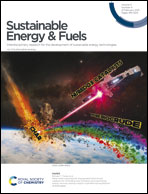H-USY and H-ZSM-5 zeolites as catalysts for HDPE conversion under a hydrogen reductive atmosphere†
Abstract
The rapid increase in the consumption of plastic caused by the abrupt growth in living standards had a noticeable effect on the plastic waste generated. Consequently, a significant number of solutions have been proposed to address this issue, with catalytic cracking under H2 atmosphere being one of the most promising ones. In this study, the catalytic conversion of HDPE under a reductive atmosphere was evaluated by thermogravimetric analysis using large and medium pore zeolites (H-USY and H-ZSM-5, respectively) with distinct Si/Al ratios as catalytic systems. The effect of adding a metallic source to zeolites was also analyzed in this work. Results show that high temperatures are required to convert HDPE (433–480 °C). However, the energy requirements can be reduced by adding a zeolite catalyst to the process. In this case, the H-USY zeolite was the most efficient catalytic system for HDPE degradation, allowing for a reduction of around 169 °C to the onset degradation temperature. The accessibility of this large pore zeolite, together with its acidic character, seems to have a determining role on the reaction. The addition of a Ni metallic source to H-USY and H-ZSM-5 led to further reduction on energy inputs. Moreover, the liquid product distribution for H-USY was shifted to lighter fractions.



 Please wait while we load your content...
Please wait while we load your content...